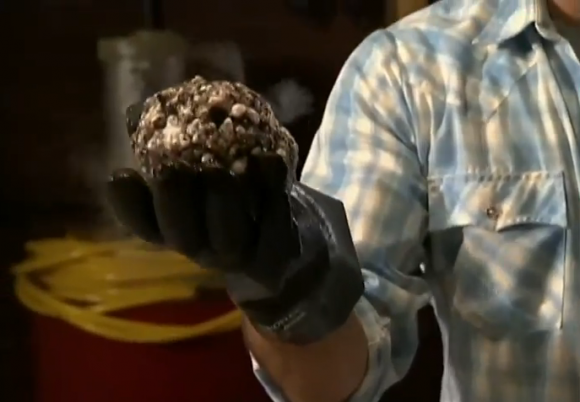How to Make a Homemade Comet With Household Ingredients, and Fun Comet Facts
A quick and easy way to make a replica of a comet. The replica is only for demonstration purposes; it won’t travel on a multi-century interstellar orbit, but it does give a good example of the popular “dirty snowball” description of the comet’s composition.
The segment is something I shot for Discovery’s HowStuffWorks – specifically the “Christmas” episode – as part of a description about how Haley’s comet was the first comet to have a predicted reappearance, back in 1758 (on Christmas day). This occurrence helped spread the new theory of orbiting celestial bodies, and allowed for greater interest in the concepts of our solar system. And now we teach these concepts at an elementary level.
The guts of a comet are believed to be a mixture of ice, dust, frozen gasses like ammonia, and organic compounds (although recent fly-by probes found that the exterior tends to be rocky, with the frozen components likely on the inside). These are ingredients that most of us have under the sink and in our garage, and using them, we can create a comet of our own.
Ingredients:
-A few handfuls of dirt
-Couple cups of water
-Few ounces of corn syrup
-Squirt or two of ammonia
-Large bowl
-Couple plastic bags
-Gloves (thick, waterproof)
-Dry ice (OK, this is the one part that might not be considered “household” — but it’s super easy to get). A few pounds will be more than adequate, and works best if smashed into as fine a powder as you can get. Do this inside one of the plastic bags, against a cement floor/sidewalk, using a hammer. Wrap it in a towel to keep the bag from tearing.
Steps:
(Wear the gloves to keep you from getting frostbite)
-Line the bowl with one of the plastic bags, opened so it can be lifted out and hold the contents
-Mix together a cup or two of water, 1/2 cup or so of dirt, the corn syrup and the ammonia
-Pour in the dry ice powder bit by bit while continuing to mix
-As it starts to slush and harden up, lift the bag out of the bowl and shape the mush inside of it into a ball until it hardens
-Pull the bag back to reveal the “dirty snowball” that you’ve formed. Sprinkle more dirt and water on the outside
The comet you’ve just formed is very similar to those flying through space. One of the fun parts about it is watching the vapor jets that escape from the fissures in the surface, especially when held close to a bright lightbulb. This is similar to the way the heat from the sun warms up a passing comet and causes its components to “steam” — which causes the signature comet tail (actually just the gas and dust trail being blown away from the sun by its cosmic winds, no matter what direction the comet is traveling).

A few more interesting facts: the orbit of Halley’s Comet has it reach just a bit past the outside of Neptune. This journey takes 75-76 years (the next appearance is 2062). Its speed ranges from 3600 km/hr at the furthest point from the sun, to 360,000 km/hr as it boomerangs around the sun at the closest point. This can be compared to the fastest spacecraft (or any other craft of human origin), the Helios I and II probes, which reached a maximum speed of 252,792 km/hr. Halley’s comet also orbits the sun in a path opposite of the planets (a “retrograde” orbit).

